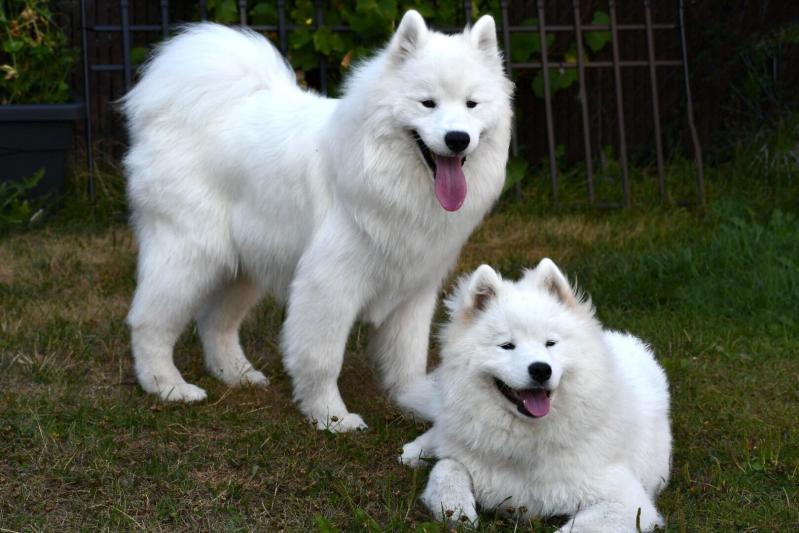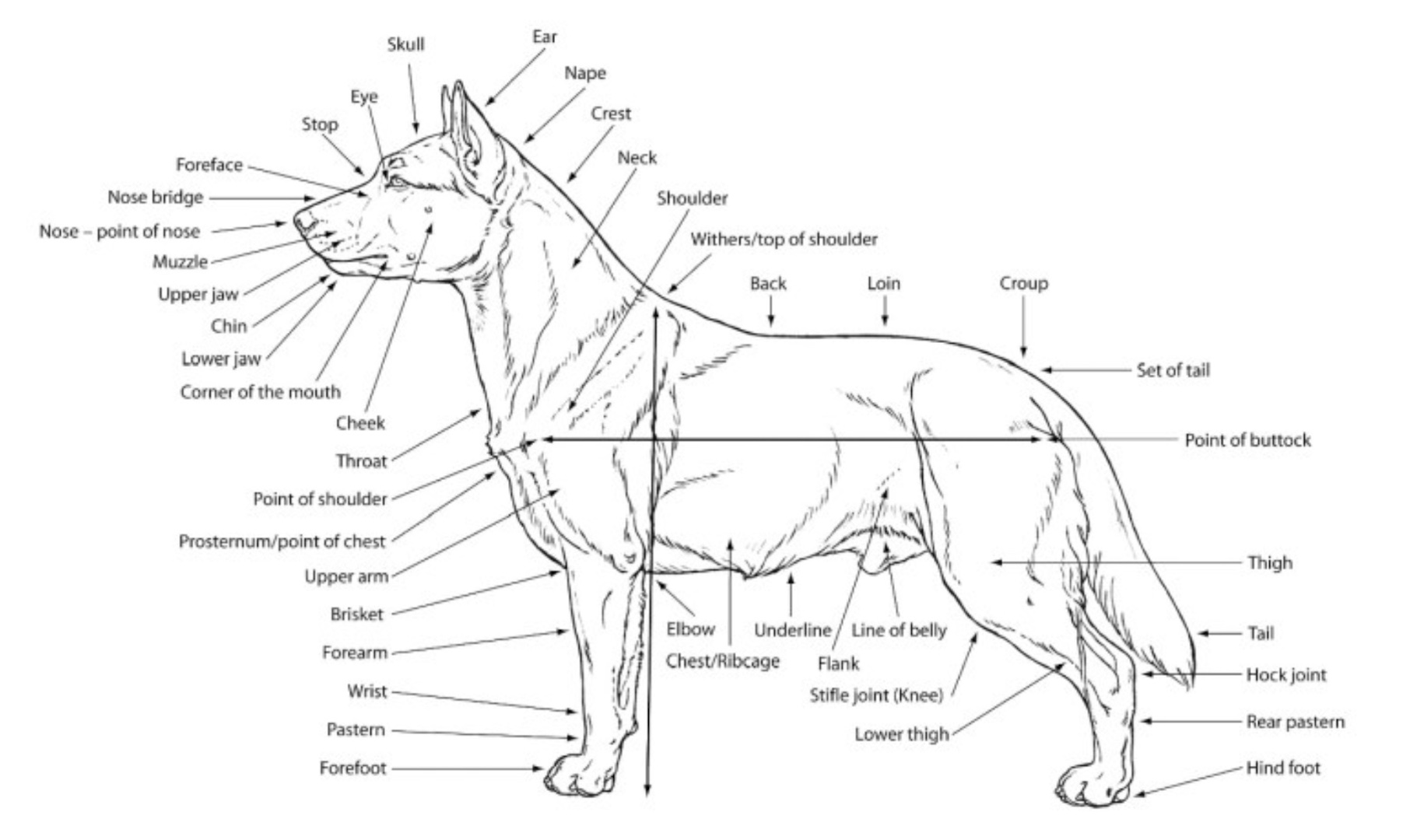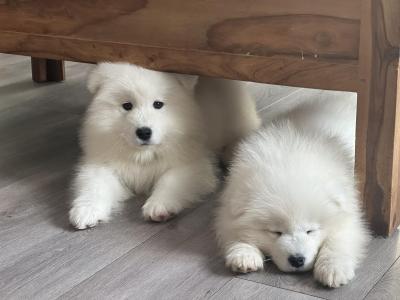SAMOYEDE : (Samoiedskaïa Sabaka)

ORIGIN:
Northern Russia and Siberia.
USE :
Dog sled and company.
BRIEF HISTORICAL SUMMARY:
The name "Samoyed" comes from the Samoyed tribes of northern Russia and Siberia. In areas south of this area, white, black, or brown dogs were used to keep reindeer herds. To the north, the dogs were pure white, were sweet in character and used as sled dogs and hunting dogs. Samoyed dogs did not leave their owners, sleeping even inside shelters where they served as a source of heat. The British zoologist Ernest Kilburn Scott spent three months with Samoyed tribes in 1889. He brought with him to England a brown male puppy called "Sabaka" (= "dog" in Russian). Later he imported a cream-colored female called "Withey Pechora" from the western side of the Urals and a snow-white male named "Musti" from Siberia. These few dogs and those brought back by the explorers form the basis of the breeding of the Western Samoyed. The first standard was written in England in 1909.
GENERAL ASPECT :
Arctic spitz white, elegant, medium size. It gives an impression of strength, endurance, charm, flexibility, dignity and assurance. The expression, which is called the Samoyed smile, results from the combination of the shape and position of the eye and the corners of the slightly turned-up lips. The sexual characteristics must be clearly marked.
IMPORTANT PROPORTIONS:
The length of the body exceeds by 5% the height at the withers. The height of the body is slightly less than half the height at the withers. The muzzle is about the same length as the skull.
BEHAVIOR / CHARACTER:
Friendly, open, awake and lively. His instinct for hunting is very weak. Never fearful or aggressive, it is not suitable as a watchdog.
HEAD:
Strong, wedge-shaped.
CRANIAL REGION:
Skull: Seen from the front and in profile, it is only slightly convex. It is the widest between the ears. Furrow slightly visible between the eyes.
Stop: Clearly marked, but not excessively.
FACIAL REGION:
Truffle: Well developed, preferably black. At certain times of the year, the pigmentation of the truffle may turn pale to give what is known as the "snow truffle" (or "winter truffle"); however, the edges of the truffle must always retain dark pigmentation.
Muzzle: Strong and tall, about the same length as the skull, going down regularly to the truffle. He is neither whistle nor heavy and square. The chamfer is straight.
Lips: Well joined, black and quite thick. The corners of the lips are slightly rolled up to form the characteristic "Samoyed smile".
Jaws / teeth: Regular and complete scissor bite. Teeth and jaws are strong. Normal teeth.
Eyes: Dark brown in color, well embedded in orbits. Quite apart, somewhat oblique, almond shaped.
The expression is "smiling", kind, awake and intelligent. The edge of the eyelids is black.
Ears: Straight, rather small, thick, triangular and slightly rounded at the tip. They must be mobile, tied up. Due to the width of the skull, they are well spaced.
NECK :
Strong, of medium length and proudly worn.
BODY :
Of length slightly greater than the height at the withers; trunk high and compact, but flexible.
Tourniquet: Markedly marked.
Back: Medium length, muscular and straight. It is slightly longer in the female than in the male.
Kidney: Short, very strong and well drawn.
Rump: Full, strong, muscular, slightly inclined.
Chest: Broad, well down and long, reaching almost elbows. The ribs are well bent.
Bottom line and belly: Moderately tucked.
TAIL:
Attached high enough. When the dog is awake or in action, the tail is carried bent forward from the base, on the back or side, but at rest, it may be hanging. She then reaches the hock.
MEMBERS
PREVIOUS MEMBERS:
Overview: Well placed and muscular with a strong frame. Viewed from the front, they are straight and parallel.
Shoulder: Long, well attached, oblique.
Arm: Oblique and well against the body. Approximately the same length as the shoulder.
Elbow: To the body.
Carp (wrist): Strong, but supple.
Metacarpus: Slightly oblique.
Forefeet: Oval, with long, flexible fingers and well forward. Arched fingers and not too tight. Elastic pads.
POSTERIOR MEMBERS:
Overview: Seen from behind, straight and parallel; very strongly muscled.
Thigh: Medium length, quite broad and muscular.
Grasset (knee): Well angulated.
Hock: quite low and well bent.
Metatarsal: Short, strong, vertical, parallel
GAIT
Powerful, uncluttered, seemingly easy, with good strides. Good extension of the anterior ones and good thrust of the hindquarters.
DRESS:
Hair quality: Polar fur, abundant, thick, supple and dense. The hair of Samoyed is double. The undercoat is soft, short and dense. The coat is longer, harder and straight. The hair should form a collar around the neck and shoulders, framing the head, especially in males. On the head and anterior surface of the limbs, the hair is short and smooth. On the outer part of the ears, the hair is short, erect and soft. The inside of the ears must be well furnished with hair. At the back of the thighs, the hair forms a panties. In interdigital spaces must push a bit of protection. The tail must be covered with abundant hair. In the female, the hair is often shorter and of softer texture than in the male. The correct texture dress should always have a shiny shine all its own.
Hair color: Pure white, cream or white and biscuit (the background color must be white with some biscuit marks). Never give the impression of being beige.
CUT :
The ideal size in the male is 57cm, with a tolerance of +/- 3cm.
In the female, it is 53cm, with a tolerance of +/- 3cm.
DEFAULTS :
Any deviation from the above must be considered as a defect that will be penalized according to its seriousness and its consequences on the health and welfare of the dog.
-Visible defects of construction.
-Light frame.
-Male not having the masculine aspect and the females not the feminine aspect.
-Articulated in clamp.
-Yellow eyes.
-Soft ears.
-Ribs in barrel.
-Tail forming a double loop.
-Dog on legs.
-Very arched members; cow hocks.
-Wavy hair or short hair all over the body; long hair, soft; hair falling.
-Character suspicious.
SERIOUS FAULTS:
Areas clearly depigmented on the edge of the eyelids or on the lips.
DEFECTS INVOLVING EXCLUSION:
-Aggressive or shy dog.
-Any dog ??with obvious abnormalities of order
-physical or behavioral will be disqualified.
-Y them blue or different colors.
-Prognathism lower or higher.
-Ears not erect.
-Other dress color than those described in the standard.
N.B .:
-Males should have two normal looking testicles fully descended into the scrotum.
-Only dogs that are healthy and able to perform the functions for which they have been selected, and whose morphology is typical of the breed, can be used for breeding.
ANATOMICAL FEATURES:

Reference: Standard FCI N° 212 , 09.01.1999 / FR
FEDERATION CYNOLOGIQUE INTERNATIONALE (FCI)


